
6
1604VLZ4
1604VLZ4
Hookup Diagrams
Recording System
Drum microphones
Vocal
mics
Headphone amp
(Connected to the
phones jack on the
front of the mixer)
Stereo Compressor
and Stereo EQ
Stereo Tape Deck
Vocal
mics
MR8mk3
studio monitors
Headphones
Stereo Guitar Effects
Stereo Guitar Effects
Synth
Stereo Compressor
Stereo Compressor
Digital Reverb
Digital Delay
Multi-track
Digital Recorder
Laptop
The rhythm and lead guitars play through stereo effects processors plugged into the line inputs of
channels 1 and 2. Microphones are connected to the mic inputs of channels 3-14 with vocal compressors
connected to the channel 3-4 and 13-14 insert jacks. [Drums are mic'd on channels 5-12]. A bass guitar
is connected to the line input of channel 15, while a synth is connected to the line input of channel 16.
A stereo compressor and stereo graphic EQ are connected to the L/R main inserts. Digital reverb and
delay processors are connected to aux sends 1 and 3, with the aux sends set to post-level. Effects are
added to the main mix via the stereo return inputs, and adjusted with the stereo return level control.
There are a multitude of recording possibilities geared for both analog purists and digital hounds.
There are three examples listed here, but feel free to experiment! (1) the RCA tape inputs and outputs are
connected to a stereo tape deck. It's an easy way to get a stereo recording of the entire band, as well as
listening to playback (over tape), (2) the eight direct outputs are connected to the eight inputs of a multi-
track digital recorder, and (3) the four subgroup outs are connected to the laptop. Again, there are many
choices for recording. Do what works for you and your setup!
A pair of MR8mk3 studio monitors are connected to the control room outputs to listen to playback of
your latest masterpiece.


















